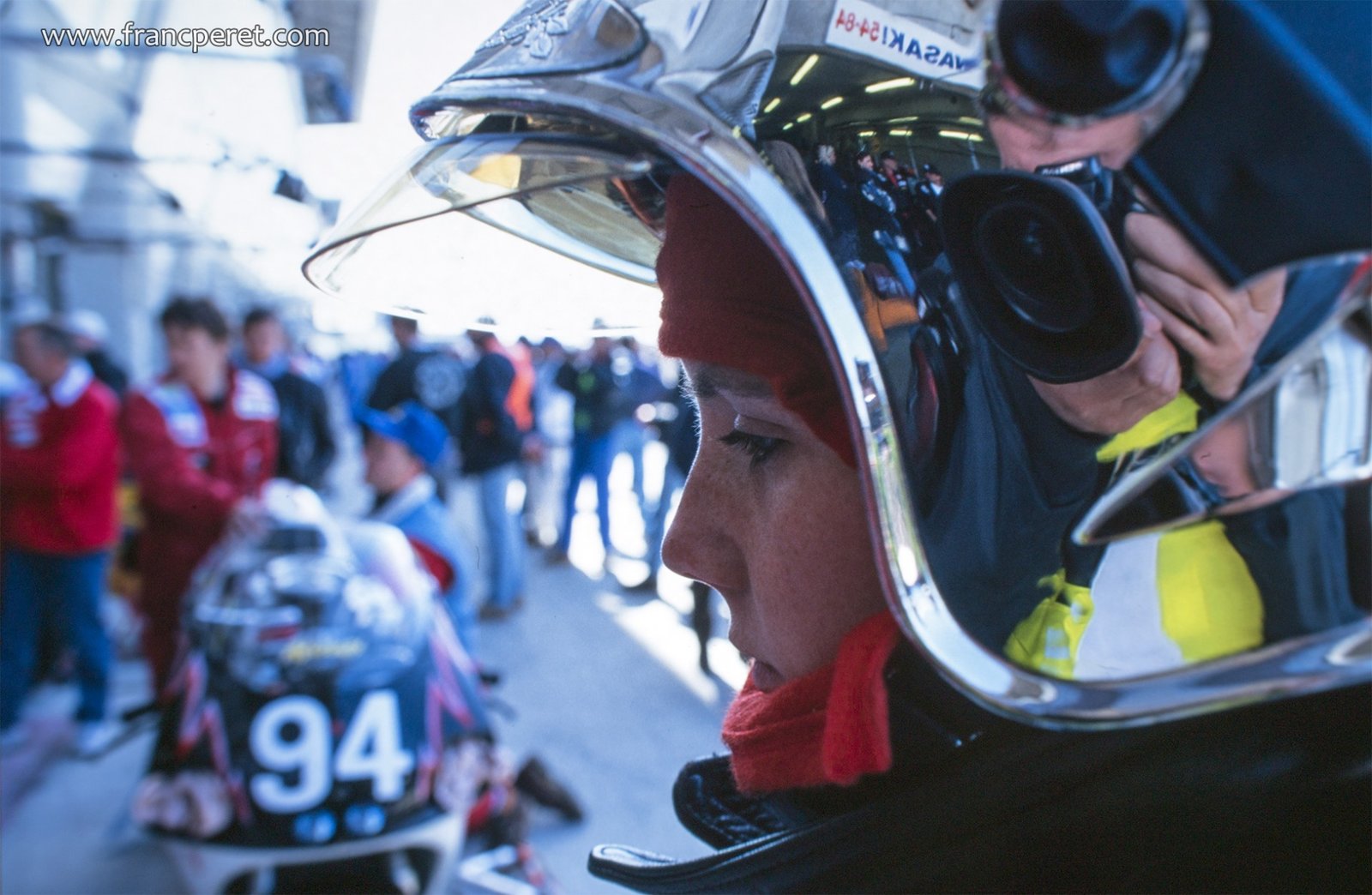
1998 24H Le Mans
24 Hours of Le Mans is one of the biggest Motorsport event in the world with 100 000 spectators and hundreds of riders competing for the most important Endurance title of the year. More than the competition itself, I focused on the ambiance on the track and the way people were enjoying the show.
Photos Franc Péret (shot on Fuji Provia ISO100)
At a very early stage of my career, practicing Motorsport myself (see some details here) before becoming a journalist, I had to master sport photography, which was a difficult task, at start.

Only experience allows to compose such a shot with a film camera, a basic auto-focus system, a very long lens (600mm f4) a challenging lighting condition and subject in high speed motion jumping into the frame.
This was especially true at the beginning of my career 28 years ago, when I was working with film camera limited to low ISO (Most of those shots had been taken with ISO 100 films), limited in number of shots (could not carry and pay for thousands of film roll) manual setting and manual focus lenses.
It is quit surprising nowadays, having so many photographers complaining, on forum, about their newly released Digital camera not being efficient enough (number of focus points, focus speed and accuracy) for shooting moving subject .
It sounds like newcomers in photography never have enough technology to compensate their lack of training or practice, and now, some are even asking for more lens or sensor stabilization and greater high ISO value.

Motorcycle Racing is based on quick decision making when the unexpected just happened. Should I go left or right?
Lack of success in Photography is rarely the fault of the camera (especially nowadays), and instead of waiting for a miracle auto-stabilized and auto-focus system able to track a specific subject at any speed and in any direction, photographer should question themselves, their knowledge and their personal skill or technique. At a certain extend, too much technical assistance is heading to the end of needed human skills to achieve creative shots. Thus, we already have a new breed of “photographers” who didn’t exist 15 years ago: the pixel peeper.
Ultimately, people who have difficulties to grab motion shots are very welcome to join my Essential Photography Class, as I am teaching to everyone “target speed”, “freezing or tracking movement”, “anticipation”, “tempo”, “predictive focus” and “tracking subject in motion”.
All the pictures posted here were shot with a film camera. I couldn’t see the result in term of sharpness, focus accuracy and exposure but this limitation didn’t forbid me to take risk and to determinate the right decision (setting and composition) in some difficult, but interesting, lighting condition while shooting high speed motorcycle in motion.
Cherry on the cake, I was at this period of my life “official” Pentax France photographer and they sponsored me by lending for free all the equipment I needed for my job.
Among my colleague, my nickname became Franc Pentax, as I signed all my published article and picture by Franc Péret(Pentax).

Bertrand, one of my former workmate (test rider at Moto Journal) won twice 24h Le Mans Race (1998/1999)
I was the only pro sport photographer in France supported by Pentax (everyone else was working with Nikon and Canon) and it lasted several years, until I left France for Japan.
Before that, I lived in Taiwan for a while and despite my new location, Pentax France kept lending me camera and lenses for my work in Taiwan. This friendly support, due to years of successful relationship, helped me greatly for starting a parallel career in film making industry.
But this is another story.
To get back to 24 H Le Mans, my main camera was a Pentax Z1p and for that specific race I got for free a 600mm f4 lens weighting almost 7 kg! (value: 5000 USD at that time!)
I needed a small trolley to carry it around the race track and a Monopod to sustain the weight while shooting.
Beside this monster i had my usual 20mm f2.8, 35mm f2, 50mm f1.4, 85mm f2.
I had auto-focus system on my camera, but this was 16 years ago technology!, with few focus point in the viewfinder and a system not that fast to react.
At that time, except the sharpness of the lens and the color of the film, the results did not depend on the technology, but was relying on the photographer skills and knowledge to be able to achieve those results.
A professional photographer was not just a guy with a camera, as it seems to be nowadays.

Magic racing moment in natural environment under late afternoon sunlight. Lets forgot about the race and feel the mood of the nature surrounding the track.
As soon as I was sure to be able to capture motion, I worked on my composition and the mood I could get out from different lighting situation.
As the race last 24 hours there was plenty of option to play with.
This was especially true as out of the race itself, I was mainly interested in the public vision of the event sharing most of my time with them behind the protective fence.
To underline this double vision, I had alternated racing shots and ambiance shots in this post for you to feel the interesting bipolarity of that event and the great possibilities for an open minded photographer.
Enjoy
Franc

100 000 spectator seen from the winner point of view, one privilege of being a professional photographer.

Car drivers are opening the space for motorcyclist to go through the traffic. 100 000 people are going back home, half of them riding motorcycle in a continuous line
Franc Peret is teaching Essential Photography Classes, Advanced Photography Workshop and Film Making Classes in Shanghai










